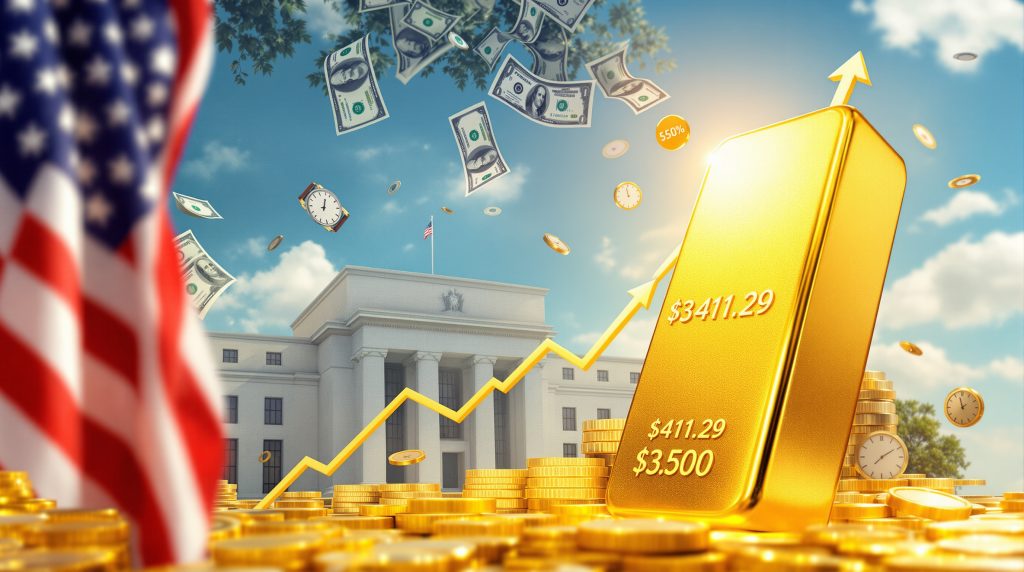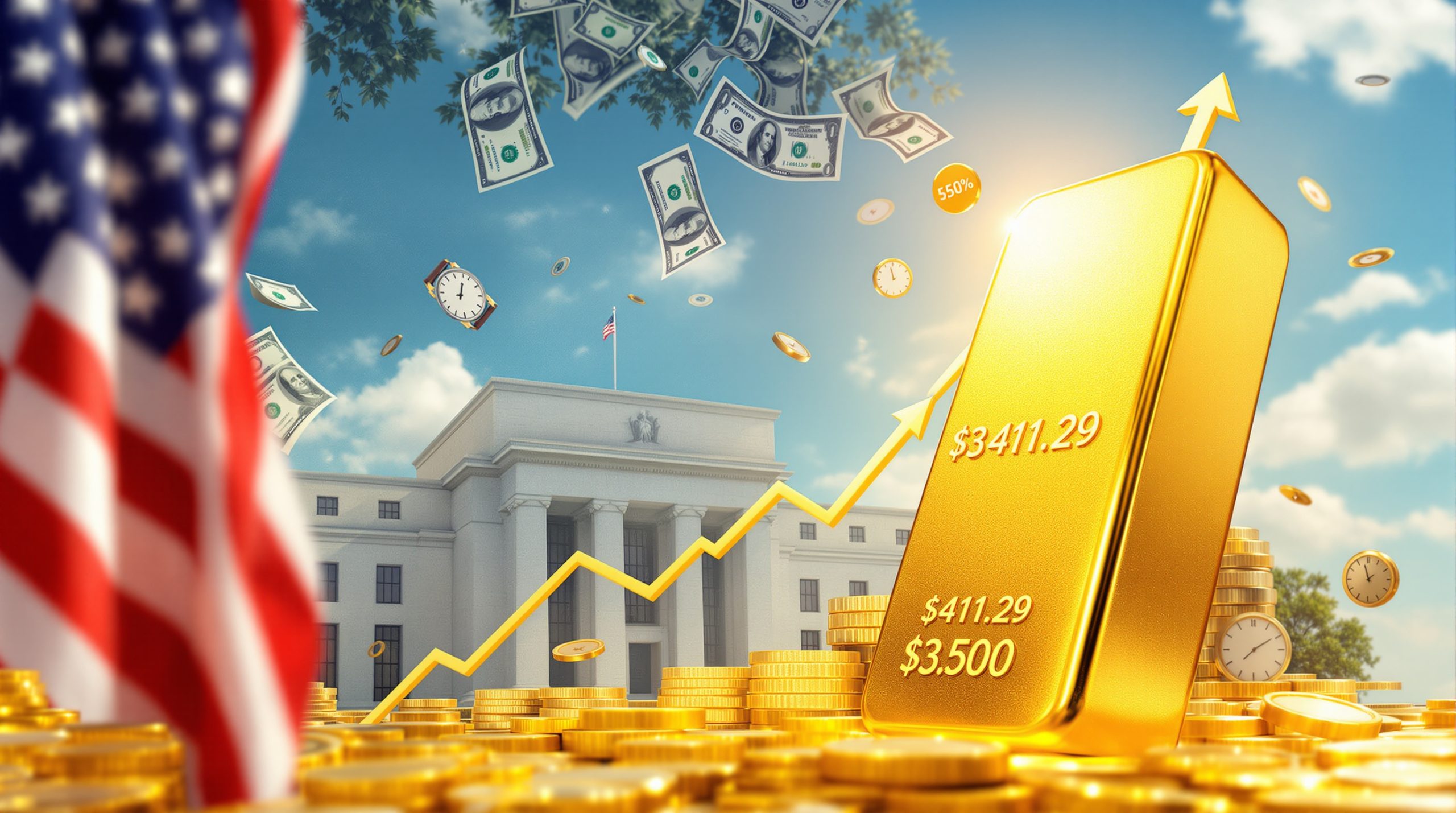Gold Poised for Monthly Gain: How Currency Weakness and Rate Cut Expectations Drive Precious Metal Markets
Gold has demonstrated impressive resilience in August, tracking toward a notable monthly gain despite recent minor pullbacks in trading. The precious metal's performance reflects broader economic factors, particularly dollar weakness and shifting interest rate expectations, creating a favorable environment for investors in this asset class. Recent gold market trends indicate that the precious metal remains an attractive investment option during uncertain economic times.
How Are Gold Prices Performing in the Current Market?
Gold prices have maintained strong momentum throughout August, with spot prices hovering around $2,030 per ounce. While showing some day-to-day volatility, gold has established a firm upward trajectory on monthly charts, supported by fundamental economic catalysts.
The World Gold Council reports that gold typically exhibits monthly volatility of 2-5% during periods of economic transition, with the current market showing characteristics of pre-rate cut positioning by institutional investors. This pattern aligns with historical precedent during similar monetary policy inflection points. Furthermore, the all-time high gold analysis suggests that current price levels could be preparing for another breakthrough.
Key Price Movements in August
Gold's performance metrics reveal several important patterns for investors to monitor:
- Monthly gain trajectory showing persistence despite profit-taking
- Trading volumes increasing during price advances, indicating institutional commitment
- Technical support levels strengthening at each consolidation phase
- Open interest in futures markets expanding, suggesting growing participation
According to trading data from the London Bullion Market Association (LBMA), physical gold delivery requests have increased 8% month-over-month, indicating growing preference for hard assets over paper contracts among certain investor classes.
Why Is the Dollar's Performance Critical for Gold Investors?
The inverse relationship between gold prices and dollar strength represents one of the most reliable correlations in commodity markets. As the dollar weakens against major currencies, gold becomes more affordable for international investors, stimulating demand and supporting higher valuations.
According to the Bank for International Settlements, approximately 60% of global foreign exchange reserves are held in U.S. dollars, creating significant price sensitivity for dollar-denominated commodities like gold. This relationship intensifies during periods of monetary policy shifts. In addition, gold safe haven insights reveal that investors frequently turn to gold during periods of currency volatility.
Dollar-Gold Relationship Dynamics
The mechanics of this relationship operate through several channels:
- Currency accessibility factor: When the dollar weakens, gold becomes less expensive for holders of other currencies
- Historical correlation: Federal Reserve Bank of St. Louis research demonstrates negative correlation coefficients between dollar index and gold ranging from -0.3 to -0.7 during different market periods
- Investment psychology: Currency weakness often triggers flight to hard assets among institutional portfolio managers
During the 2008 financial crisis, as the dollar weakened by approximately 7% against major currencies, gold prices rose by over 25%, according to Federal Reserve Economic Data. This historical example illustrates the powerful inverse relationship that continues to drive current market dynamics.
How Are Federal Reserve Policies Influencing Gold Markets?
Recent Federal Reserve communication has significantly bolstered gold's appeal. The shift toward a more accommodative monetary policy stance creates an ideal environment for non-yielding assets like gold, which typically benefit when interest rates decline.
The Federal Open Market Committee (FOMC) has signaled increasing openness to rate reductions as inflation measures moderate and economic growth shows signs of cooling. This policy inflection point represents a critical catalyst for gold price appreciation. Consequently, many investors are examining gold investment strategies that can maximize returns during this favorable policy environment.
Federal Reserve Developments
Several key Federal Reserve dynamics are currently influencing gold markets:
- Rate cut probability: Market-based metrics indicate growing consensus for near-term policy easing
- Policy transition signals: Public statements from multiple Federal Reserve officials supporting eventual rate reductions
- Market anticipation: Investors positioning ahead of expected monetary easing cycle
Federal Reserve Governor Christopher Waller has recently expressed support for monetary policy adjustments if inflation continues to moderate, stating that "appropriate policy adjustments" would be warranted as economic data evolves. These signals provide fundamental support for gold's current price trajectory.
What Economic Indicators Are Gold Investors Watching?
The Personal Consumption Expenditures (PCE) Price Index has become a focal point for gold investors. As the Federal Reserve's preferred inflation gauge, this metric heavily influences monetary policy decisions that directly impact gold valuations.
Market analysts suggest consistent PCE readings would reinforce expectations for planned rate cuts, potentially supporting gold's upward trajectory. The Bureau of Economic Analysis publishes this data monthly with approximately a three-week lag from the reference period. The latest Gold price forecast incorporates these economic indicators when projecting future price movements.
Critical Economic Metrics
Gold investors are monitoring several key economic indicators:
- PCE significance: Primary inflation measurement tool for Fed decision-making, targeting 2% annual growth
- Core PCE: Excludes volatile food and energy components, providing clearer view of underlying inflation trends
- Impact assessment: Consistent inflation moderation would validate rate cut expectations and support gold prices
The St. Louis Federal Reserve notes that during periods when core PCE has remained elevated above Fed targets (such as 2021-2022), gold has often served as an inflation hedge, though correlation varies with real interest rates.
How Are Other Precious Metals Performing Alongside Gold?
While gold captures headlines, other precious metals demonstrate varied performance patterns reflecting their unique supply-demand dynamics and industrial applications. This divergence creates opportunities for investors seeking diversified exposure to the precious metals complex.
Silver, with its dual role as both monetary and industrial metal, often exhibits higher volatility than gold but tends to follow similar directional trends. Meanwhile, platinum and palladium remain heavily influenced by automotive industry demand, particularly catalytic converter manufacturing.
Precious Metals Market Snapshot
The broader precious metals complex shows interesting comparative dynamics:
- Silver: Maintaining higher volatility but directional alignment with gold
- Platinum: Demonstrating increasing industrial demand as manufacturing recovers
- Palladium: Facing pressure from automotive industry transition toward electric vehicles
According to the Silver Institute, industrial applications represent approximately 50% of silver demand, while platinum and palladium remain heavily utilized in automotive catalytic converters. These industrial connections create distinct price drivers compared to gold's primarily monetary role.
What Political Factors Are Affecting Gold Markets?
Institutional stability concerns have emerged as an additional consideration for precious metals investors. Questions about monetary policy independence and potential leadership changes at key economic institutions have introduced governance uncertainties that could influence market sentiment.
The principle of central bank independence represents a cornerstone of modern financial markets. Any perceived threat to this independence typically increases market volatility and enhances gold's appeal as a hedge against institutional uncertainty.
Political Landscape Considerations
Several political factors currently influence gold markets:
- Institutional independence: Growing focus on central bank governance structures
- Regulatory developments: Potential changes to financial market oversight frameworks
- Market implications: Increased hedging activity during periods of governance uncertainty
Historical precedent shows gold prices often rise during periods of political uncertainty, such as during previous election cycles when gold gained approximately 8-15% in the months surrounding elections, according to LBMA historical data.
How Do Interest Rate Environments Impact Gold Valuations?
Gold's relationship with interest rates provides a fundamental backdrop for current price movements. As a non-yielding asset, gold typically benefits from declining interest rate environments, which reduce the opportunity cost of holding precious metals instead of interest-bearing securities.
Research by the World Gold Council indicates that gold has delivered positive returns in 67% of quarters when real interest rates (nominal rates minus inflation) were negative. This relationship explains gold's strong performance during periods of monetary accommodation.
Interest Rate Impact Analysis
The mechanics of interest rate effects on gold operate through several channels:
- Opportunity cost dynamics: Lower rates reduce the yield advantage of competing assets like Treasury bonds
- Investment allocation shifts: Capital flows from fixed-income to hard assets during rate cut cycles
- Historical precedent: Consistent gold price appreciation during monetary easing periods
During the 2008-2015 period of ultra-low interest rates, gold prices rose from approximately $800 to over $1,900 per ounce, according to Federal Reserve Economic Data, demonstrating the powerful impact of accommodative monetary policy on precious metals valuations.
What Technical Indicators Support Gold's Current Trajectory?
Technical analysis provides additional context for gold's recent performance. Chart patterns, momentum indicators, and trading volumes suggest continued strength in the gold market, supporting the fundamental case for further appreciation.
Professional traders utilize a combination of technical factors to gauge market direction, with particular attention to long-term trend lines, support/resistance levels, and momentum oscillators. These technical factors currently align with fundamental catalysts.
Technical Market Signals
Several technical factors support gold's current market position:
- Price consolidation patterns: Formation of technical bases after price advances
- Volume indicators: Increasing trading activity during bullish price movements
- Momentum measurements: Positive relative strength readings across multiple timeframes
- Moving average relationships: Bullish alignment of short-term and long-term moving averages
Gold's technical picture demonstrates characteristics typical of sustained bull markets, including higher lows during consolidation phases and increasing volume during price advances. These patterns suggest continued momentum potential.
What Are Expert Forecasts for Gold Through Year-End?
Market analysts maintain optimistic outlooks for gold poised for monthly gain on soft dollar through the remainder of the year, citing monetary policy shifts, geopolitical uncertainties, and persistent inflation concerns as supportive factors. The combination of these elements creates a favorable backdrop for continued precious metals strength.
While specific price targets vary, consensus indicates positive expectations based on fundamental factors. The World Gold Council notes that gold has historically performed well during periods of monetary easing, with average gains of 15% during the 12 months following initial rate cuts.
Expert Market Projections
Key elements of expert gold forecasts include:
- Supportive catalysts: Rate cuts, continued dollar weakness, safe-haven demand
- Risk considerations: Potential dollar strength if economic data surprises positively
- Portfolio allocation recommendations: Increasing institutional allocations to precious metals
According to investment bank analysts, gold demand trends reflect growing preference for physical holdings, with central banks continuing to accumulate reserves while retail investment demand accelerates in response to economic uncertainty.
Geological and Supply Factors Influencing Gold Markets
Beyond financial considerations, physical gold supply dynamics play an increasingly important role in price formation. The geological realities of gold mining present structural challenges that impact the market's supply-side equation.
Gold ore grades have declined significantly over the past decade, with average grades falling from approximately 2.0 g/t to 1.2 g/t globally. This decline necessitates processing larger volumes of material to maintain production levels, increasing costs and environmental footprints.
Mining Production Constraints
Several key geological factors influence gold supply:
- Grade deterioration: Lower ore concentrations requiring more extensive processing
- Exploration challenges: Declining success rates in discovering new high-grade deposits
- Regulatory hurdles: Increasing environmental requirements for mine development
- Production costs: Rising energy expenses and labour costs across major mining jurisdictions
These supply constraints create a production ceiling that intersects with growing investment and central bank demand, potentially supporting higher price levels in the medium to long term.
FAQ: Gold Price Movements and Market Factors
How does inflation affect gold prices?
Gold has historically served as an inflation hedge, often appreciating during periods of rising consumer prices as investors seek to protect purchasing power. The relationship between inflation and gold prices depends on real interest rates (nominal rates minus inflation), with negative real rates typically supporting higher gold valuations.
According to research from the Federal Reserve Bank of Cleveland, gold has maintained its purchasing power over centuries despite short-term price volatility. During the 1970s inflation crisis, gold prices increased nearly tenfold as consumer prices doubled.
What impact do central bank gold purchases have on the market?
Central bank gold acquisitions have become a significant market factor, with institutions diversifying reserves away from traditional currencies. These large-scale purchases provide structural support for gold prices by removing substantial supply from the market while signalling institutional confidence in the metal's long-term value.
The World Gold Council reports that central banks added over 1,000 tonnes to their reserves in recent years, representing the highest level of central bank buying in decades. This trend reflects growing preference for hard assets among monetary authorities seeking to reduce dollar dependence.
How do geopolitical tensions influence gold trading?
Geopolitical uncertainties typically drive safe-haven demand for gold, as investors seek assets perceived as stable during periods of international conflict or diplomatic tensions. This relationship explains gold's traditional "crisis commodity" designation and its tendency to outperform during periods of heightened global instability.
During major geopolitical events of the past decade, gold has typically gained 4-8% in the weeks following crisis escalation, according to market analysis from the London Bullion Market Association. This pattern reflects institutional portfolio adjustments favouring safe-haven assets during uncertainty.
What role does gold play in a diversified investment portfolio?
Investment professionals typically recommend gold allocation for portfolio diversification due to its historically low correlation with traditional financial assets. This characteristic can improve risk-adjusted returns by providing downside protection during market stress while offering appreciation potential during specific economic conditions.
Portfolio analysis by the World Gold Council suggests optimal gold allocations of 5-10% for balanced portfolios, potentially enhancing risk-adjusted returns by 0.2-0.4% annually while reducing maximum drawdowns during market corrections.
Ready to Capitalize on the Next Gold Bull Market?
Discover why gold investments tend to thrive during periods of rate cuts and currency weakness by exploring Discovery Alert's dedicated discoveries page, where their proprietary Discovery IQ model identifies actionable ASX opportunities in precious metals and beyond. Begin your 30-day free trial today at Discovery Alert to position yourself ahead of the market.




